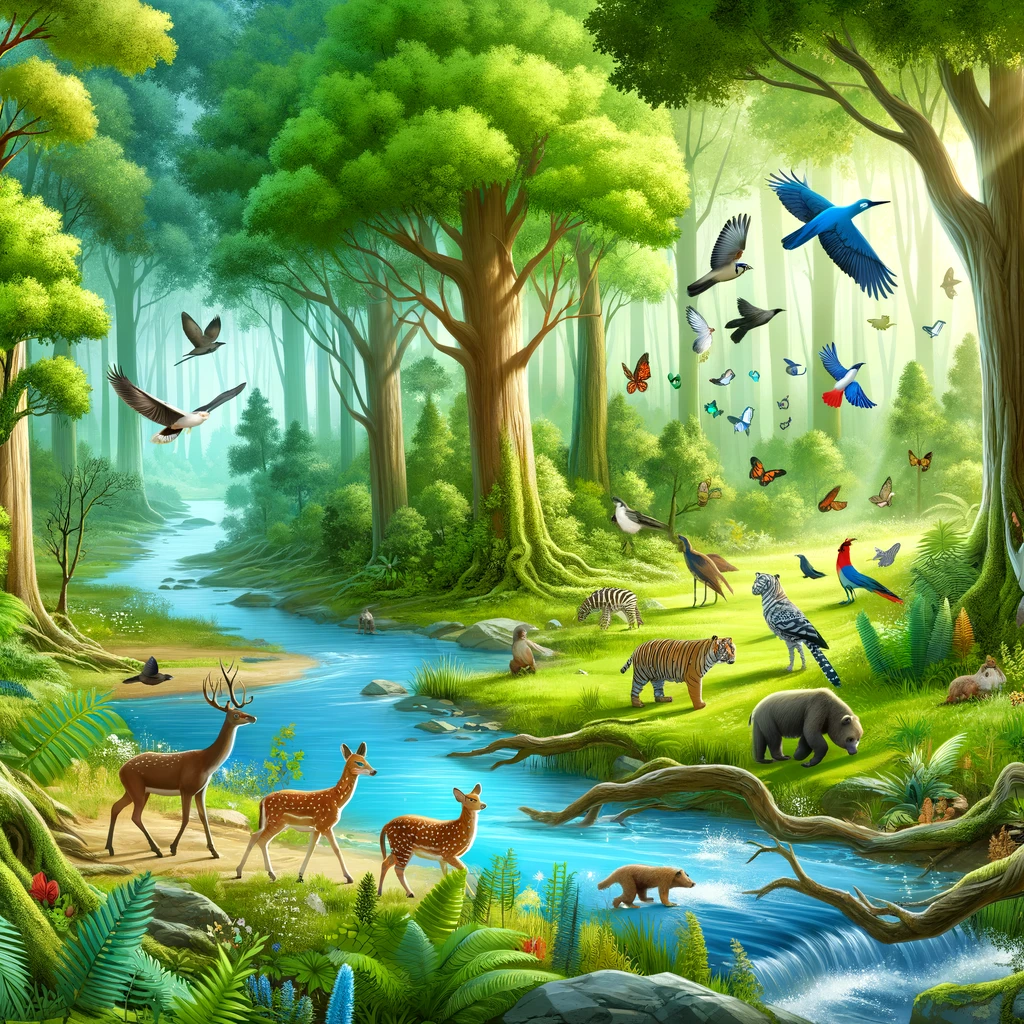 The Indispensable Benefits of Trees to Our Environment and Health
The Indispensable Benefits of Trees to Our Environment and Health
Introduction
Trees transcend their role as mere visual enhancers in our landscapes; they are essential pillars of ecological and human health. Functioning as natural air purifiers and providers of tranquil, green spaces, trees enrich our lives in profound ways. At HQ Landscaping, we’ve recognized this importance for over three decades, dedicating ourselves to planting approximately 250 trees each year. This ongoing effort has resulted in a total of 7,500 trees planted—a testament to our commitment to both environmental sustainability and community well-being.
The Vital Science of Tree Planting
Trees are not just aesthetic elements but are critical environmental utilities. They engage in photosynthesis, absorbing carbon dioxide—a primary greenhouse gas—and converting it into oxygen, which is vital for life on Earth. Statistically, a mature tree can absorb about 48 pounds of CO2 annually. Through our planting initiatives, HQ Landscaping’s trees have collectively absorbed around 360,000 pounds, or 180 tons, of CO2 over the last 30 years. This substantial contribution underscores the pivotal role trees play in climate regulation and atmospheric cleanliness.
Human Benefits Extending Beyond Carbon Storage
Improvement of Air Quality
Trees serve as nature’s air purifiers, playing an invaluable role in urban and rural landscapes alike. They possess an innate ability to absorb a range of gaseous pollutants, including nitrogen oxides, ammonia, and sulfur dioxide—common byproducts of industrial processes and vehicle emissions. The leaves and bark of trees act like a sponge, trapping these pollutants on their surfaces. During photosynthesis, trees also take in carbon dioxide and convert it into oxygen, thus cleaning the air we breathe.
Nitrogen oxides are significant contributors to smog and acid rain. They can impair human health, leading to respiratory issues such as asthma and bronchitis. Trees mitigate these effects by absorbing these gases through their stomata, tiny openings on the leaves, and metabolizing them into less harmful substances.
Ammonia, emanating largely from agricultural processes, can also be toxic when concentrations are high. Trees help to filter this chemical from the air, preventing it from contributing to the formation of particulate matter, which is harmful when inhaled.
Sulfur dioxide is another pollutant with the potential to cause acid rain, which harms ecosystems and man-made structures. Trees absorb sulfur dioxide through their leaves, where it is eventually incorporated into the soil, neutralized by the alkaline earth metals, and used as a nutrient in various biological processes.
Beyond these chemical interactions, the structure of trees themselves contributes to their air scrubbing capacity. Their vast canopies intercept particulate matter—tiny particles that can penetrate deep into the lungs and even enter the bloodstream—thereby reducing the concentration of these particles in the air.
In urban environments, where concrete and asphalt can amplify heat and trap pollutants, trees provide a cooling effect. This is not just due to the shade they cast but also because of the water they release into the atmosphere through transpiration. This has a dual benefit: it cools the air and further assists in the removal of pollutants.
Moreover, the greenery provided by trees has been shown to promote mental and physical well-being, encouraging outdoor activities and social interaction, which are vital components of public health, especially in densely populated areas where such opportunities may be limited.
In sum, the presence of trees is integral to maintaining a clean air supply, which is crucial for the health of the population and the environment. Their ability to filter harmful pollutants and transform urban spaces into healthier habitats is one of the many reasons why initiatives like urban forestry and tree-planting campaigns are critical in the quest for sustainable cities.
Reduction of Urban Heat
Trees are a crucial component in the battle against urban heat islands—a phenomenon where city centers are significantly warmer than their rural surroundings due to human activities. The hard surfaces of buildings, roads, and other infrastructure absorb and re-emit the sun’s heat more than natural landscapes, leading to elevated temperatures. Trees counteract this effect through two primary mechanisms: shade and evapotranspiration.
Shading Effect: Trees provide shade, creating a cooling effect on the environment. Their canopies intercept solar radiation, preventing it from hitting the ground or surfaces of buildings directly. This reduces the heat absorbed and stored by these surfaces during the day, which would otherwise be released into the surrounding air, raising temperatures. The shade from a tree can significantly lower temperatures on the surfaces it covers, and because shaded areas feel cooler, this can reduce the urban heat island effect at a local level.
Evapotranspiration: Evapotranspiration is the process by which water is transferred from the land to the atmosphere by evaporation from soil and other surfaces and by transpiration from plants. As trees transpire, they release water vapor through their leaves, which cools the air as the water vapor absorbs heat to evaporate. This process acts much like a natural air conditioner, with the capacity for a single mature tree to transpire hundreds of gallons of water in a day, having a significant cooling effect on its immediate surroundings.
Energy Consumption and Emissions Reduction: By naturally cooling the environment, trees reduce the reliance on artificial air conditioning. This is particularly impactful during peak summer temperatures when electricity demand for cooling can lead to increased energy production, often from fossil fuels. The consequent emissions from power plants, including CO2, nitrogen oxides, and sulfur dioxide, contribute to greenhouse gas effects and air pollution. By lowering the need for artificial cooling, trees therefore help to reduce these emissions.
The cooling effect of trees can also be strategic. For instance, planting trees on the southern and western sides of buildings can provide maximum shade during the hottest times of the day. This can significantly cut down indoor temperatures and reduce the energy used for cooling.
Broader Environmental and Social Benefits: Beyond their direct cooling impact, trees also contribute to reducing stormwater runoff, protecting against erosion, and improving air quality. The additional shade can extend the life of pavement and reduce the ‘heat stress’ on surrounding vegetation, enabling more robust green spaces.
Socially, cooler temperatures can improve comfort levels and health outcomes for city residents, reducing heat-related illnesses, which are critical in vulnerable populations such as the elderly and those with preexisting health conditions.
In summary, trees serve as a vital natural tool in urban planning, combating the urban heat island effect, reducing energy consumption, and cutting down on emissions. They are an indispensable part of sustainable urban development, contributing to more livable and healthful city environments.
Support for Biodiversity
Trees are integral to the balance and diversity of ecosystems. They function as the architectural framework for habitats, offering food, shelter, and nesting sites for a multitude of organisms, thus maintaining the intricate web of life that characterizes a healthy ecosystem.
Habitat and Shelter:
The physical structure of a tree provides various microhabitats within its branches, leaves, bark, and roots. Cavities within trunks can serve as nesting sites for birds and bats, while the dense foliage offers shelter for arboreal species, protecting them from predators and harsh weather. The roots of trees create complex networks that provide shelter for ground-dwelling creatures and contribute to soil stability, preventing erosion and creating a foundation for other vegetation to thrive.
Food Resources:
Trees are a vital source of nourishment for wildlife. They produce a range of foods, including fruits, nuts, leaves, buds, and sap, which are essential to the diets of many animals. In turn, these animals play a crucial role in the dispersal of seeds and pollination, facilitating the propagation of tree species and the continuation of forested landscapes.
Biodiversity Support:
Trees support biodiversity at multiple levels. They are host to a variety of fungi, lichens, mosses, and insects, which all play specific roles in the ecosystem. Insects, such as bees and butterflies, rely on trees for nectar and pollen, and are crucial pollinators for many plant species. The decline of a single tree species can have a ripple effect, impacting numerous other species that are directly or indirectly dependent on that tree for survival.
Ecological Balance:
By providing diverse habitats and food sources, trees help to maintain the balance among predator and prey species within an ecosystem. This balance is critical for the health and function of ecosystems, influencing everything from local plant diversity to the presence of large predators.
Carbon Sequestration and Oxygen Production:
Trees are significant carbon sinks, meaning they store carbon that would otherwise contribute to atmospheric greenhouse gases. This carbon sequestration not only combats global warming but also contributes to the production of oxygen through photosynthesis, which is essential for most life forms on Earth.
Soil Health and Water Cycle:
Trees play a pivotal role in soil health, with their fallen leaves providing organic matter that enriches the soil with nutrients. This, in turn, supports other plant life and soil organisms. Additionally, trees are vital components of the water cycle, as they draw water from the soil and release it into the atmosphere through transpiration, contributing to cloud formation and precipitation patterns.
Cultural and Aesthetic Value:
Beyond their ecological importance, trees offer significant cultural and aesthetic value. They have been a central element in many cultures’ mythologies and religions and continue to be symbols of life and growth. Aesthetic appreciation of trees can foster a connection to nature and encourage conservation efforts.
In conclusion, trees’ role in supporting wildlife, maintaining ecological balance, and contributing to the health of our planet is profound. Their conservation and propagation are essential not only for the countless species that rely on them but also for the overall health of the planet and the well-being of human societies.
 The Devastating Impact of Deforestation
The Devastating Impact of Deforestation
Deforestation poses one of the most serious threats to global biodiversity and the ecological balance of our planet. When trees are cut down and forests are cleared, the consequences are multifaceted and severe.
Rising CO2 Levels: Trees play a critical role in carbon sequestration, acting as carbon sinks that absorb and store carbon dioxide from the atmosphere. The process of deforestation releases this stored carbon back into the air, exacerbating the greenhouse effect and accelerating climate change. The loss of forested areas also means there are fewer trees to absorb CO2 going forward, which further intensifies global warming.
Water Biochemistry and Hydrological Cycle Disruption: Trees are essential in maintaining the water cycle. They draw up groundwater through their roots and release water vapor into the atmosphere through transpiration, contributing to cloud formation and precipitation. Without trees, this cycle is disrupted, leading to changes in rainfall patterns and the biochemistry of water bodies. This can result in drought in some areas while causing flooding in others.
Soil Erosion: The roots of trees bind soil together, and their canopy reduces the impact of heavy rains on the soil surface. Deforestation leaves soil exposed and highly vulnerable to erosion. The topsoil, which is vital for plant growth, is washed away, leading to the loss of fertile land and the silting of rivers, lakes, and dams, which can have devastating consequences for agriculture and water quality.
Loss of Biodiversity: Forests are home to more than 80% of terrestrial species of animals, plants, and insects. When their habitats are destroyed, they face extinction. This loss of biodiversity has far-reaching implications for ecosystems, as it reduces genetic diversity and the resilience of species to pests, diseases, and environmental changes.
Local Climate Change: Trees influence their environment by moderating temperatures, maintaining humidity, and sheltering wildlife. The removal of trees can lead to drastic changes in local climates, often making them more extreme. This can affect not just the local flora and fauna but also the human populations that depend on the stable conditions provided by forests.
Socio-Economic Impact: Many indigenous communities rely on forests for their livelihoods, using them for shelter, food, and medicine. Deforestation can thus have severe socio-economic consequences, displacing communities, and leading to a loss of cultural heritage.
To address the detrimental effects of deforestation, it is essential to implement and support comprehensive reforestation efforts. Planting trees is not simply about increasing forest cover but restoring entire ecosystems. Conservation strategies must protect existing forests, restore damaged ones, and ensure the sustainable management of forest resources. Such strategies involve not only planting new trees but also preserving the mature ones that are irreplaceable in their ecological functions.
It is equally important to address the root causes of deforestation, such as agricultural expansion, logging, and mining, by promoting sustainable practices and creating economic incentives for conservation. The survival of our forests is intrinsically linked to the health of our planet and the well-being of all species, including humans. Protecting them is not just an environmental responsibility—it’s crucial for our survival.
Conclusion
The commitment of organizations like HQ Landscaping to tree planting and environmental stewardship exemplifies the critical steps needed toward sustainable ecological management. By understanding the substantial benefits that trees offer to the environment and human health, we reinforce the necessity of integrating tree planting into urban planning and global forestry management. Let us continue to advocate for and nurture these vital natural resources for future generations.
